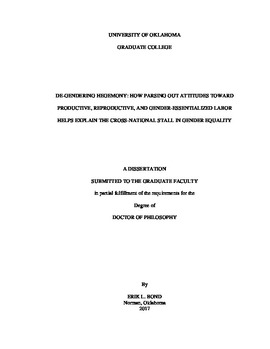| dc.description.abstract | Starting with the problem of the two-decade stall in the developed world’s gender revolution, this project applies Structural Equation Modeling (SEM) techniques to answer three related questions: (1) “How have attitudes concerning gender-labor equality asymmetrically penetrated the developed world?” (2) “Can researchers better refine measurement of gender-labor attitudes by modeling a gender-essentialized concept of labor roles as distinct from more conventional attitudinal measures?” (3) “Does modeling this separate dimension improve our understandings of persistent gender-labor biases?” To answer these questions, I explore markers of gender-labor attitudes using data from 29 OECD countries (N = 37,632) in the 2012 wave of the International Social Survey Programme, a transnational, level-matched data set drawing mostly from OECD nations. Much of the research in this area treats progressive gender ideology as being composed of a largely homogenous set of values categorized under an umbrella often labeled “Gender Egalitarianism,” “Feminism” or something similar. However, my project works to demonstrate that this social construct is actually composed of a heterogeneous set of values that may vary widely in representation across country, sex, and labor status. I put forth a new theoretical framework—dubbed “Hegemonic Coupling Theory” (HCT)—which asserts that the intersections of hegemonic statuses (such as masculinity and paid employment) reinforce and sustain inequality independently of inequalities specific to either component status. I answer each of the project’s main questions in a separate analysis. First, I explore descriptive statistics for key attitudinal asymmetries across my twenty-nine-country sample. Second, using SEM, I compare three measurement models to demonstrate that a model treating three latent dimensions of gendered labor attitudes as distinct from one another (as asserted in HCT) is a better fit than two other models that treat them as overlapping or uniform. Finally, I show that the distinct attitudinal dimensions vary significantly across national welfare regime, sex, and other demographic factors. In sum, this project demonstrates that (1) meaningful attitudinal asymmetries do exist at the national and international levels, (2) the value set commonly labeled “gender egalitarianism” consists of a heterogeneous set of values, and (3) A gender-essentialized conception of labor roles remains an important and anomalous factor perpetuating gender-labor biases. These findings support the usefulness of the framework outlined in HCT. I conclude by recommending policy initiatives that would target lagging dimensions of gender egalitarianism and promote equity more effectively than the broad-based, generalized policies of years past. | en_US |
